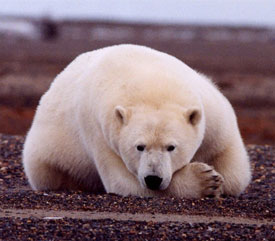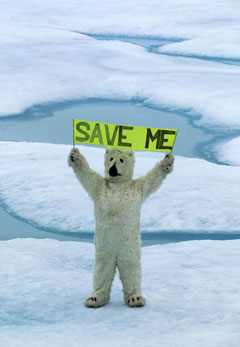Bush administration says polar bears under threat
Bush administration says polar bears under threat
mongabay.com
December 27, 2006
Today the Bush Administration said polar bears are in need of protection. The reason? Global warming. The administration says that climate change is causing sea ice to melt, putting the polar bear in peril.
“Polar bears are one of nature’s ultimate survivors, able to live and thrive in one of the world’s harshest environments,” said Dirk Kempthorne, Secretary of the Department of the Interior. “But we are concerned the polar bear’s habitat may literally be melting.”
Wednesday Kempthorne proposed listing polar bears as a “threatened” species under the Endangered Species Act, a move that would require federal agencies to take steps to protect the species’ habitat. The decision could impact oil and gas exploration in Alaska as well as have broader implications for U.S. emissions of heat-trapping greenhouse gases like carbon dioxide, which are blamed for rising global temperatures.
 Polar bear Courtesy of the U.S. Fish and Wildlife Service |
Kempthorne’s announcement comes after a series of studies have shown that polar bears are increasingly at risk due to warming temperatures in the Arctic.
A November study published by scientists from the U.S. Geological Survey and the Canadian Wildlife Service, found a 22 percent decline in the size of the western Hudson Bay polar bear population, from 1,194 in 1987 to 935 in 2004. The research also found that only 43 percent of polar bear cubs in the surveyed area survived their first year, compared to a 65 percent survival rate in the late 1980s and early 1990s.
Other reports indicate that drowned polar bears are being found for the first time in Alaska. Researchers speculate that greater distances between ice sheets could be taking a toll on the bears. While bears are capable of swimming long distances—up to 60 miles (100 km) without stopping—it is conceivable that they could suffer from exhaustion during an unexpectedly arduous swim.
 Photo courtesy of Greenpeace |
The loss of ice also makes it more difficult for bears to find food. Unlike grizzly bears, polar bears aren’t adapted to hunting land animals like caribou, instead feeding primarily on seals. However, recent aerial surveys by the U.S. Fish and Wildlife Service show that, over the past five years, polar bears are changing their habits and spending more time on land, congregating on beaches and scavenging whale carcasses.
“Polar bears live much of their lives on the sea ice, which is fundamental for their survival, at least in terms of their traditional lifestyles. For instance, it’s the sea ice surface that provides them a platform from which to hunt seals and other marine mammals for food,” said Claire Parkinson, a senior scientist at NASA’s Goddard Space Flight Center, in a September news release. A shorter spring hunting season caused by progressively earlier breakup of sea ice, reduces the chances of reproductive success for female polar bears.
In September, Ian Stirling, a research scientist with the Canadian Wildlife Service, noted that the average weight of adult female polar bears in western Hudson Bay have fallen from 650 pounds in 1980 to just 507 pounds in 2004, a 22 percent reduction.
Extrapolating from these developments, some scientists believe that polar bears could be extinct in the wild within the next century. While the last survey in 1997 suggested that polar bears in Alaska were not endangered, next year’s update might come to a different conclusion. Scientists estimate there are currently 20,000 to 25,000 polar bears world-wide.
This article used information from previous mongbay.com articles, a news release from University of Wyoming, and a Retuers report.